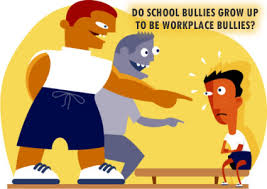Lesson 2: Psychosocial Causes of Abnormal Behaviour
Peers
 As with familial relationships, peer relationships can be both healthy and unhealthy. Young children need to learn about give-and-take, empathy, kindness, and assertiveness with others. These are difficult concepts for adults to understand, so it is unreasonable to expect children to develop perfect peer relationship skills readily. Much trial and error will occur. Adult support is vital during this period of development. Some detrimental experiences that a child may face are school yard bullying and prejudice due to economic status, race, religious beliefs, gender, sexual orientation, physical characteristics, dress, or place of origin. Problems such as lowered self-confidence and self–esteem are often the result of negative childhood experiences.
As with familial relationships, peer relationships can be both healthy and unhealthy. Young children need to learn about give-and-take, empathy, kindness, and assertiveness with others. These are difficult concepts for adults to understand, so it is unreasonable to expect children to develop perfect peer relationship skills readily. Much trial and error will occur. Adult support is vital during this period of development. Some detrimental experiences that a child may face are school yard bullying and prejudice due to economic status, race, religious beliefs, gender, sexual orientation, physical characteristics, dress, or place of origin. Problems such as lowered self-confidence and self–esteem are often the result of negative childhood experiences.


 Bullying is not confined to childhood. Many adults experience the negative effects of bullying in the workplace. Please review the following article (Chris Morris, 2004).
Bullying is not confined to childhood. Many adults experience the negative effects of bullying in the workplace. Please review the following article (Chris Morris, 2004).
Workplace bullying strikes chord in many, researcher finds
“Bullying targets usually good performers who react by quitting.” For fed-up nurses at one New Brunswick hospital, “code pink” is their unique way of coping with the scourge of the bully boss. The nurses could no longer stand the vile temper and bad language directed at them by one particularly belligerent physician, but hospital administrators were not sympathetic.
|
“They came up with a solution on their own to curb his behavior,” said Marilyn Noble, a Fredericton-based researcher in workplace bullying, “When he is on a rant, they call a code pink. Any nurse who can spare the time comes and stands in a circle as a silent observer and watches him. The impact is he looks up, realizes there are witnesses who might report him and he shuts down.” “If I talk to 100 people in social situations and I say I’m working on workplace bullying, there might be two people who look at me like I’ve got three heads, and there would be 98 who would grab me by the arm and say, “Have I got a story for you,’” she said. It’s a major safety issue, she said “Once in a while, we see people driven to such extremes they may lash out at the company, not only in the form of a lawsuit, but violently.” |
 Workplace bullies—people who target workers for intimidation, belittlement and humiliation—are themselves are becoming the targets of individuals and groups promoting respectful and safe workplaces in Canada. Noble, one of two researchers studying workplace bullying at the Muriel McQueen Fergusson Centre for Family Violence Research in Fredricton, says she has been besieged by people with stories to tell about bullies in their offices. Heather Gray of Edmonton, president and CEO of the consulting firm Threat Assessment and Management Associates Inc., said there’s much more at stake in controlling bullying than simply keeping workers happy and productive.
Workplace bullies—people who target workers for intimidation, belittlement and humiliation—are themselves are becoming the targets of individuals and groups promoting respectful and safe workplaces in Canada. Noble, one of two researchers studying workplace bullying at the Muriel McQueen Fergusson Centre for Family Violence Research in Fredricton, says she has been besieged by people with stories to tell about bullies in their offices. Heather Gray of Edmonton, president and CEO of the consulting firm Threat Assessment and Management Associates Inc., said there’s much more at stake in controlling bullying than simply keeping workers happy and productive.
Gray points to the case of OC Transpo in Ottawa, where four employees were fatally shot in April 1999 by Pierre Lebrun, who then took his own life. Lebrun had been teased and tormented for years by his co-workers at OC, but the company had never addressed the bullying problem.
|
“Self-esteem is damaged to the point where they’re not functioning well at work and in their personal relationships. It does an extraordinary amount of damage to the individual.” “There are mean-spirited people who have no power or control in other parts of their life so they exercise it in the workplace,” she said. “Some of these people have very poor interpersonal skills and there are others who simply get glee out of putting other people down and making them squirm.” |
Gray said she is particularly disturbed when firms boast that bullying tactics are their way of forcing people to quit. She says companies need to be aware of the damage caused by those tactics. Gray said bullies have a number of traits in common. They are usually in supervisory roles and their overriding objectives are power, domination and subjugation.
The targets of bullies also have traits in common. Gray said they’re generally good performers and are often targeted because of their competence, which may threaten the bully supervisor. Gray says targeted workers are not wired the same way as the bully and most quit their jobs.
Although federal legislation is pending that will help protect federal public servants from workplace bullies, most legislation in Canada offers little or no help. Noble says the ultimate solution is for companies to identify interveners at every level of their operations; unbiased people to whom workers can go with a complaint.
Video: Workplace Bullying